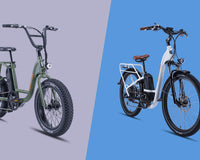Let’s hear it for our batteries! They’re the reason we’re able to ride further, go faster, and conquer hills without breaking a sweat. It’s safe to say that if you love your ebike, you love your battery.
Since they do so much for us, it only makes sense to return the favor and take proper care of your bike and battery to maximize their lifetime.
Here are a few best practices aimed at keeping both you and your little 48V friend happy.
1. Avoid Salt and Saltwater.

Salt is a great partner for caramel and countless other culinary delights, but it is less so for your battery. Salt has corrosive properties and high electrical conductivity. As such, we advise against riding your ebike in areas where you’re likely to encounter salts, like directly on the beach or roads that have been recently de-iced.
If you do come across salt or saltwater, however, there are steps you can take to help minimize any damage to your bike or battery.
Remove your battery, wipe down the battery case and battery tray with a clean dry rag, and ensure the connections are dry and clean. Then use a clean rag dampened with fresh water to clean the bike frame and mechanical components and let them dry completely before putting the battery back on. Make sure to avoid spraying water directly into electrical components, like your display or battery tray.
Regular maintenance, like lubricating your chain, is always important but should be practiced more frequently when there’s the possibility of salt or saltwater exposure.
Pro tip: We know it’s sometimes difficult to detect exposure, but you can generally tell when the bike has encountered salt or saltwater by the white, chalky residue that salt leaves behind.
2. Dodge Puddles!

Your bike is designed to withstand the elements, but puddles can sometimes pose hidden dangers to your battery.
For example, let’s say you’re going out for your first ride after a big snow day. The ice may have melted, but there’s a possibility that when it turned to slush, it mixed with salt on the road and turned into a big puddle of saltwater.
It’s better not to risk it and to ride cautiously to avoid puddles or standing water. When riding in groups, keep a safe distance between bikes to avoid salt spray off tires, and avoid riding where cars can splash you.
It’s also worth remembering that puddles can hide bigger obstacles that can be hazardous to you and your bike. They’re sneaky like that.
This should go without saying, but you should never immerse or submerge either your battery or your bike in water or other liquid. This can damage your electrical system or cause a hazardous situation.
3. Keep it Cool, Not Cold.
There aren't many people that get particularly excited by extreme temperatures, and your ebike is in the would-rather-play-it-cool camp as well.
Avoid riding your bike in temperatures lower than minus 4°F to help maintain normal battery operations. When not in use, keep the bike and battery stored together in a clean, dry, temperature-controlled environment between 50°F and 77°F.
If you’re in a situation where you have to store your bike in less than ideal conditions, take the battery off and bring it inside. Store it in a cool, dry place away from direct sunlight, dirt, debris, high temperatures, and corrosive household items until it’s time to ride again.
If you're putting your battery away for more than two weeks, keep it at around 75 percent charged and check on it every month to make sure it's staying at that level. Keeping it fully charged or fully depleted while in storage can lead to range loss or render it inoperable. A day or two is not a cause for concern, but after a while, it starts to add up.
4. Stick with the Battery and Charger that came with your bike.
We’re not trying to trick you into relying solely on our products, but utilizing the battery and battery charger that comes with your Rad Power Bikes-branded ebike is honestly one of the most important steps you can take to keep your bike running optimally.
The Rad battery and charger are designed to work together. Rad has tested the heck out of charging the battery using the charger we created to do exactly that job.
Switching it up and using third-party batteries or chargers could result in the battery being charged too fast or losing capacity. Too much heat can land your battery in trouble, including major, irreparable damage.
5. Unplug the Charger Once Your Battery is Fully Charged

Charging the battery from completely empty to completely full typically takes between 3–7 hours (this applies to both our Standard and RadMission 1 Battery Packs.)
The charger is designed to stop charging automatically when the battery is fully charged. Nevertheless, we recommend you disconnect the battery from the power source and charger as soon as possible once charging is complete. As with any appliance, you should unplug your charger when you’re not using it to charger your battery. This will also prevent range decline from unnecessary charging.
When you’re charging up for a ride, keep an eye on the red and green light indicators on the charger. Remove the charger from the battery as soon as you see both a red and green light.
6. Travel Smart
Who wouldn’t want to bring their electric bike on a road trip? When you strap yours to a bike rack or place it in the back of a truck bed, remove the battery as an added safeguard against the elements and to avoid the risk that it might fall off your bike if it’s not attached correctly. In addition, bike racks have maximum weight limits, and removing the battery can save you up to 7.7 pounds.
Wipe down the battery with a dry piece of cloth and store it inside the vehicle. When it’s time to take a spin, just slide it back on.
We do not recommend driving with your ebike on a hitch rack in rainy conditions, as the electrical system may be damaged. If you must, cover your bike, or do not drive with it through the rain for an extended period of time. Afterward, park the bike in a dry location to allow the bike systems to dry out before use.
Now that you're ready to take charge of your ride, plan your next trip with our guide to your battery's range. For additional information, check out these tips on maximizing your battery life, riding in cold weather, and our comprehensive online help center.






